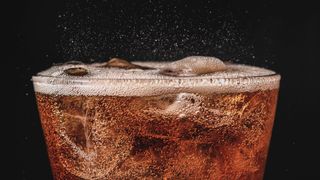
Why does soda fizz?
Soda's effervescence comes from carbon dioxide bubbles.

The dancing, tingling fizz of soda has delighted the world for centuries. But what is the secret behind these bubbles?
The fizz in soda consists of bubbles of carbon dioxide, or CO2. Carbonated drinks are infused with this colorless, odorless gas at high pressures during production until the liquid becomes supersaturated with the gas.
"Soda fizzes because it's made to fizz," Mark Jones, an industrial chemist and fellow of the American Chemical Society, told Live Science.
Naturally carbonated beverages like beer and kombucha that rely on fermentation for their fizz have been around for ages. But the advent of modern carbonated sodas can be traced to English clergyman and scientist Joseph Priestley, who is nicknamed "the father of the soft drinks industry," for developing a carbonating apparatus in 1772, according to Britannica. By 1794, Swiss jeweler Jacob Schweppe was selling carbonated artificial mineral waters to his friends in Geneva.
Related: Why do soft drinks go flat?
At first, bottled carbonated water was used medicinally, Britannica noted. Flavors were added later — ginger by about 1820, and lemon in the 1830s. In 1886, pharmacist John Pemberton in Atlanta, Georgia, invented Coca-Cola, the first cola drink.
Carbonation not only leads to a dancing froth, but also reacts with the water to generate carbonic acid, resulting in a slightly tangy flavor. Although the carbonic acid and any other flavor-enhancing acids that soda-makers add to soft drinks has been linked to tooth damage, "I think the American Dental Association is more concerned about the sugar in soda," Jones said.
Sign up for the Live Science daily newsletter now
Get the world’s most fascinating discoveries delivered straight to your inbox.
When soda is bottled, the soft drinks are kept very cold because carbon dioxide dissolves better in soda at low temperatures. "Warming up a liquid forces gas out of the solution," Joe Glajch, an analytical chemist and pharmaceutical chemistry consultant, told Live Science.
After soda is infused with carbon dioxide, the gas effervescently escapes due to a principle in physical chemistry known as Henry's law, proposed by British chemist William Henry in 1803, according to Britannica. Henry's law states that the amount of a gas dissolved in a liquid is proportional to the pressure of that same gas in the liquid's surroundings.
When soda is canned or bottled, the space above the drink is usually filled with carbon dioxide at a pressure slightly above that of standard atmospheric pressure (about 14.7 pounds per square inch, or 101.325 kilopascals), Glajch said. Because of Henry's law — and the pressure of the gas trapped at the top of the sealed container — the carbon dioxide that's dissolved in the beverage stays within the fluid.
However, when a soda container is opened, the pressurized carbon releases into the air. This venting gas produces the signature hiss one expects to hear from a newly opened soda bottle or can. "A soda bottle is effectively a pressure vessel that will hold that pressure in until you open the top," Jones said. (If a can or bottle has been shaken or otherwise disturbed before it is opened, gas trapped within the liquid can escape to join the gas above the beverage, increasing the pressure in the gas above the fluid and resulting in the soda bursting out when the container is opened.)
Carbon dioxide makes up about 0.04% of Earth's atmosphere, according to Columbia University's Climate School. Henry's law suggests that when soda is exposed to air, the carbon dioxide in the soft drink naturally wants to reach the same concentration in the fluid as in the air. The result is that most of it fizzes out of the liquid as tiny CO2 bubbles.
Soda fizzes even more when it is poured into a glass because the act of pouring greatly increases the surface area of the liquid and helps the bubbles escape, Glajch said. "A good example of this can be seen with beer," Glajch said. "If you pour a beer into a glass, you can get a good size head of foam on top, depending on the kind of beer and how carbonated it is. That foam is all gas coming from the beverage."
One trick to reduce the amount of bubbling during pouring — and thereby enabling a soft drink to stay fizzy longer — is to pour the soda along the side of the glass. "That drastically decreases the surface area of the pour" and thus preserves more CO2 in the liquid, Glajch said. Bottoms up!
Originally published on Live Science in Feb. 13, 2013 and rewritten on June 25, 2022.
